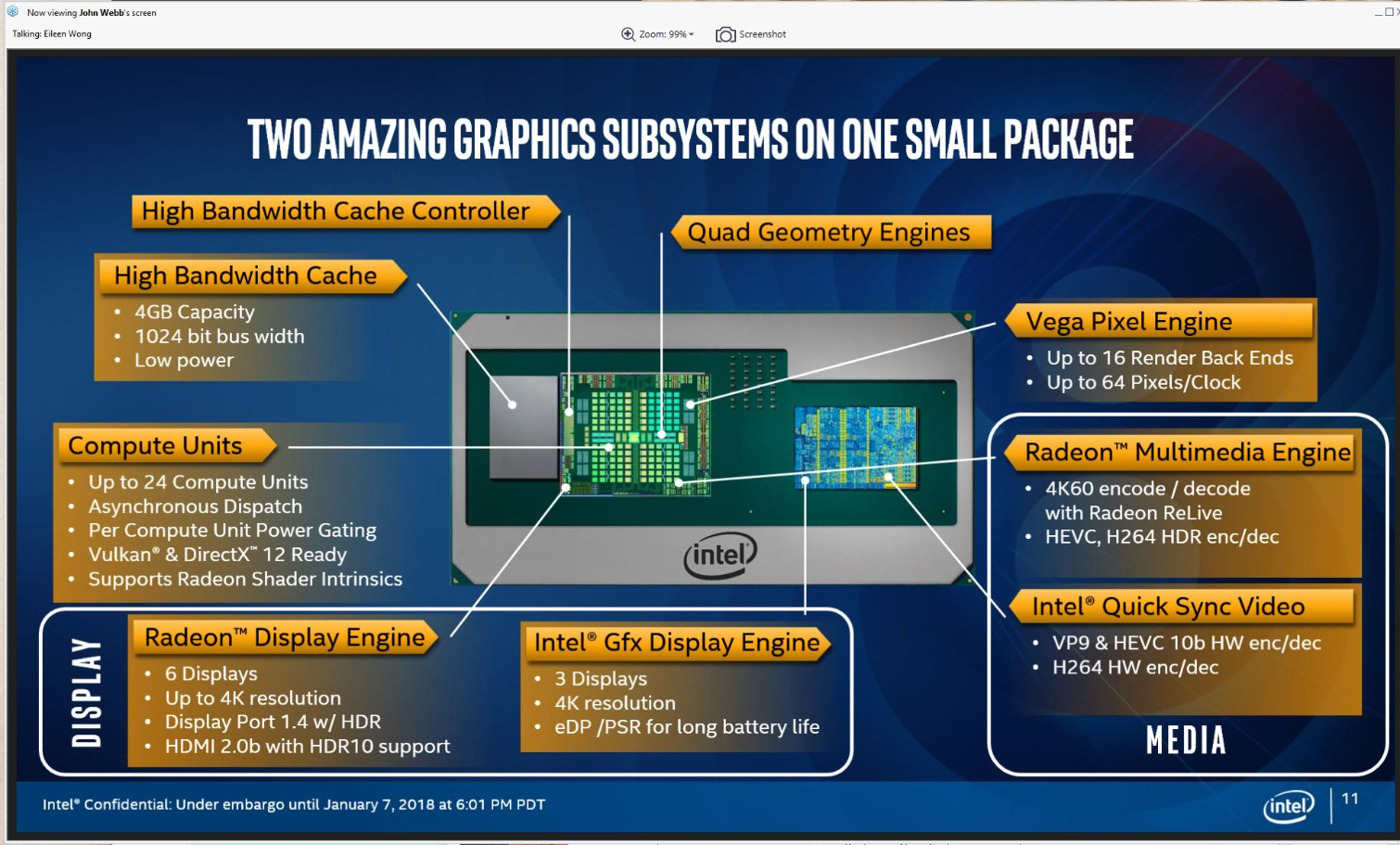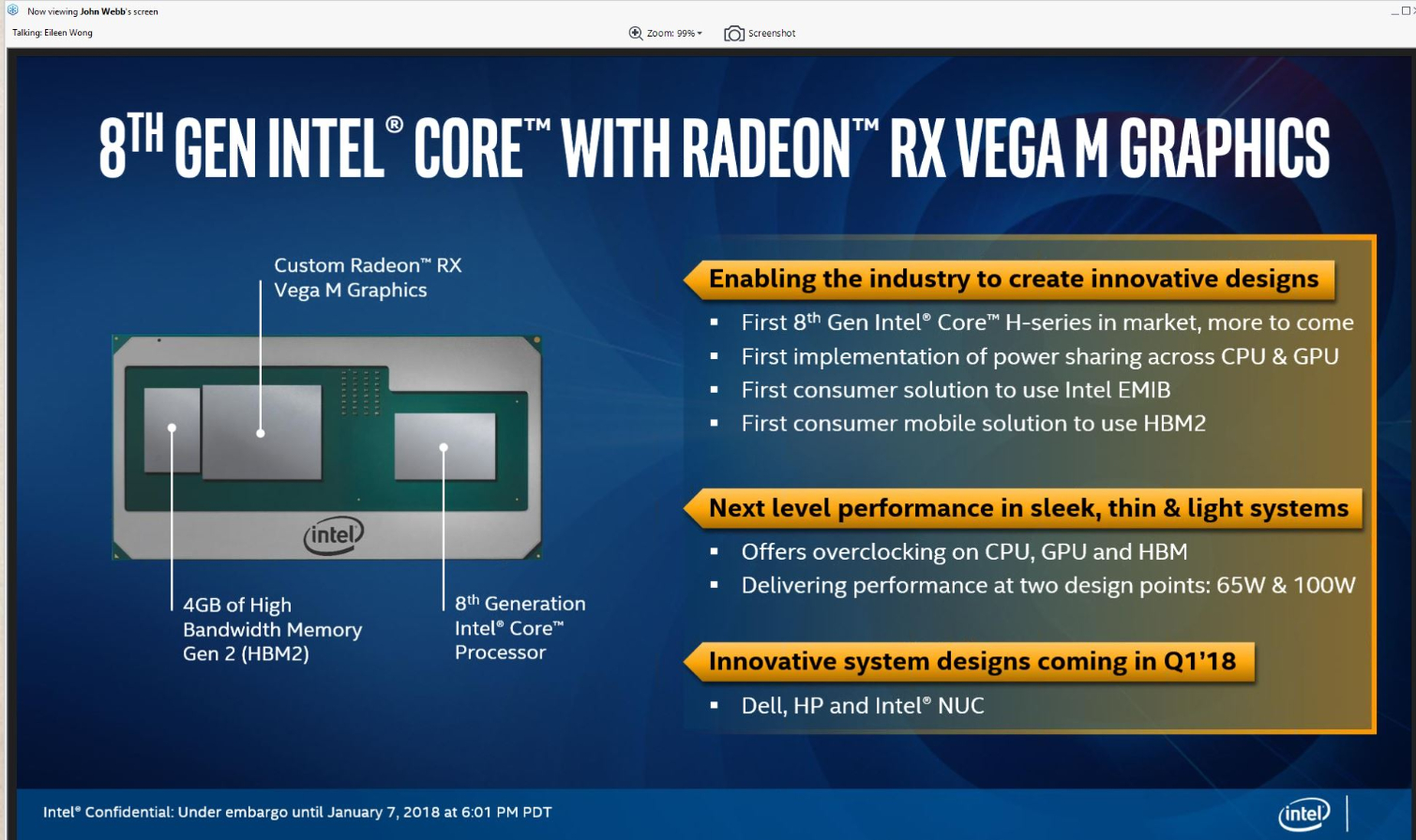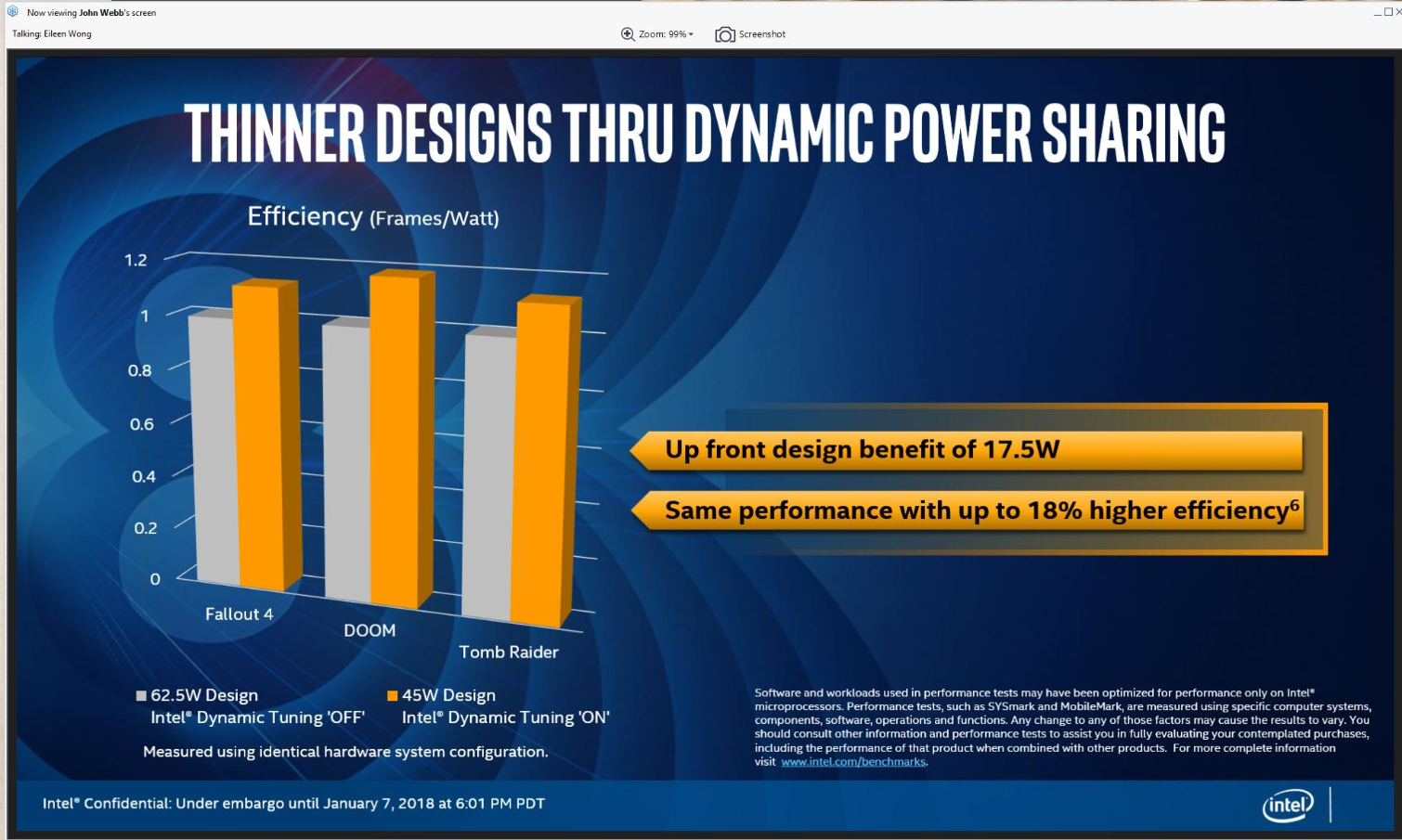Early Verdict
Intel's Kaby Lake-G processors offer surprisingly good performance in an incredibly small package. The NUC8i7HVK is agile in games and applications, and it offers the connectivity to satisfy true enthusiasts. Just be ready to shell out some serious cash for the privilege of owning one. You're also on the hook for storage, memory, and an operating system.
Pros
- +
Good 1080p gaming performance
- +
Good application performance
- +
Unlocked multipliers
Cons
- -
Price
- -
Thermal limitations
- -
Relatively large power supply
Why you can trust Tom's Hardware
Splashing Into Kaby Lake-G
We usually hear rumors of new processor launches months before they happen, so truly earth-shaking announcements are rare. But AMD’s disclosure last year that it was creating a semi-custom GPU for its bitter rival Intel was genuinely surprising.
As a result, though, Intel's eighth-gen mobile Core processor rides on the same package as an AMD Radeon RX Vega graphics chip, complemented by 4GB of HBM2. This configuration is meant to address the shortcomings of Intel's own HD Graphics engine, allowing mini-PCs, thin-and-lights, and notebooks to deliver a smoother gaming experience. Intel claims its new chips should serve up similar graphics performance as Nvidia's GeForce GTX 1060 Max-Q.
The processors are also fast enough to drive larger devices like the overclockable 100W Hades Canyon NUC we're testing today. A graphics card shortage continues to confound gamers, so this launch couldn't come at a better time for Intel. Can a marriage of two unlikely bedfellows capture the hearts of enthusiasts, though?
Intel NUC 8 VR
Intel crams as much performance as possible into its Hades Canyon NUCs. The overclockable $1000 NUC8i7HVK "NUC 8 VR" is based on a 100W Core i7-8809G, while the $800 NUC8i7HNK dials back to a 65W Core i7-8705G. Both are barebones platforms though, meaning you'll need to spend even more on memory, storage, and an operating system. At least the two NUCs are loaded with connectivity options. You get support for up to six 4K displays, Thunderbolt 3, and 7.1-channel audio.
The VR NUC specifically includes provisions for overclocking the CPU, GPU, HBM2, and system memory. Clearly, Intel designed the NUC8i7HVK with enthusiasts in mind. After all, its case features Intel's Skulltrail logo up top, illuminated by LEDs, while the power button sports lighting that you can adjust.
These NUCs occupy 1.2L enclosures, which are slightly larger than the previous-gen Skull Canyon model. They accommodate up to 32GB (2 x 16GB) of DDR4-2400 memory in SO-DIMMs running at 1.2V, though you can overclock beyond DDR4-3466 with a capable kit. You're also able to install a pair of M.2 SSDs in either SATA or NVMe flavors. Naturally, the 100-series chipset supports Intel's blistering-fast Optane drives, too.
Intel covers its NUC with a three-year warranty, though that doesn't include damage incurred by overclocking. Whereas Intel will sell you a policy to protect its K-series CPUs, there is no option to purchase overclocking coverage for the NUC.
Get Tom's Hardware's best news and in-depth reviews, straight to your inbox.
Intel Kaby Lake-G MCM
Intel officially calls its new hybrid CPU/GPU packages eighth-gen Core mobile processors with Radeon RX Vega M graphics. We prefer the Kaby Lake-G code name, though, so we're sticking with that. The company doesn't license AMD's technology for these multi-chip modules. Instead, Intel buys them just like AMD's other customers, then integrates them onto MCMs.





The new design combines a CPU (right), Vega graphics (middle), and HBM2 memory (left) onto one package. Like all Intel processors of this class, Kaby Lake-G comes equipped with 20 third-gen PCIe lanes, eight of which are monopolized by the GPU. The package also connects to a PCH across a four-lane DMI 3.0 link.
Kaby Lake-G features one small HBM2 stack connected to AMD's GPU through EMIB (Embedded Multi-Die Interconnect Bridge) technology. In a nutshell, the EMIB interconnect is a packaging capability that ties discrete chips together via silicon bridges. It eliminates interposers, thereby reducing package thickness to 1.7mm. The interconnect also consumes less power than interposer designs, and allows Intel to place the HBM2 and GPU closer together. This minimizes physical dimensions, improves bandwidth, and reduces latency.
As an example of what this form factor enables, Kaby Lake-G processors can fit into 16mm-thick devices like the Dell XPS 15 2-in-1 we recently examined. That's much thinner than the ~26mm z-height typical of notebooks with discrete GPUs.
Intel Core i7-8809G
Intel carves its mobile processors into the U-series for mainstream mobility, the G-series for thin-and-lights with integrated graphics, and H-series processors for the high-performance segment. Kaby Lake-G packages use H-series CPUs.
| Intel Processors | Core i7-8809G | Core i7-8709G | Core i7-8706G | Core i7-8705G | Core i5-8350G |
| TDP / SDP | 100W | 100W | 65W | 65W | 65W |
| Core/Threads | 4 / 8 | 4 / 8 | 4 / 8 | 4 / 8 | 4 / 8 |
| Base Frequency (GHz) | 3.1 | 3.1 | 3.1 | 3.1 | 2.8 |
| Boost Frequency (GHz) | 4.2 | 4.1 | 4.1 | 4.1 | 3.8 |
| L3 Cache (MB) | 8 | 8 | 8 | 8 | 6 |
| Memory Channels | Dual-Channel | Dual-Channel | Dual-Channel | Dual-Channel | Dual-Channel |
| Memory Speed | DDR4-2400 | DDR4-2400 | DDR4-2400 | DDR4-2400 | DDR4-2400 |
| Unlocked CPU, GPU, HBM2 | Yes | No | No | No | No |
| Discrete Graphics | Radeon RX Vega M GH | Radeon RX Vega M GH | Radeon RX Vega M GL | Radeon RX Vega M GL | Radeon RX Vega M GL |
| Intel HD Graphics | 630 | 630 | 630 | 630 | 630 |
| Graphics Boost Frequency (MHz) | up to 1100 | up to 1100 | up to 1100 | up to 1100 | up to 1100 |
| Intel vPro Technology | No | No | Yes | No | No |
Intel only uses the Core i7-8809G and -8705G in its NUCs; other Kaby Lake-G models will find homes in mobility-focused devices. The 14nm+ CPU dies are paired with either Radeon RX Vega M GH or Radeon RX Vega M GL GPUs. The GH cleverly stands for "Graphics High," while GL means (you guessed it) "Graphics Low." The GH models have a 100W TDP, whereas the GL models are rated at 65W.
The flagship Core i7-8809G features four Hyper-Threaded cores and 8MB of L3 cache. It accelerates up to 4.2 GHz via Turbo Boost, but has a base clock rate of 3.1 GHz.
All Kaby Lake-Gs support dual-channel DDR4-2400 (no ECC) memory. You'll notice that they also sport HD Graphics 630 and AMD's discrete GPU, too. Intel doesn't use its integrated engine for either NUC's display outputs. Instead, that hardware remains available for OpenCL-based compute workloads and QuickSync-accelerated software.
Some Kaby Lake-G products will use HD Graphics 630 for driving up to three 4K monitors. In those cases, the processor will power gate (turn off) the Vega GPU and its HBM2 during light graphics workloads.
| Processors | Core i7-8809G, i7-8709G | Core i7-8706G, i7-8705G, i5-8305G | Ryzen 2400G | Ryzen 2200G |
| Graphics Version | Radeon RX Vega M GH | Radeon RX Vega M GL | - | - |
| Architecture | Vega M | Vega M | Vega | Vega |
| Compute Units | 24 | 20 | 11 | 8 |
| Stream Processors | 1536 | 1280 | 704 | 512 |
| Base GPU Clock (MHz) | 1063 | 931 | ? | ? |
| Boost GPU Clock (MHz) | 1190 | 1011 | 1250 | 1100 |
| Memory Bandwidth (GB/s) | 204.8 | 179.2 | - | - |
| Peak Power Consumption | 130W | ? | - | - |
| Peak SP Performance (TFLOPS) | up to 3.7 | up to 2.6 | up to 1.76 | up to 1.126 |
| Texture Units | 96 | 80 | 44 | 32 |
| ROP Pixels/clk | 64 | 32 | 16 | 16 |
| Memory Bus | 1024-bit | 1024-bit | - | - |
| High Bandwidth Cache | 4GB HBM2 | 4GB HBM2 | - | - |
The Radeon RX Vega M GH sports 24 CUs, totaling 1536 Stream processors. It features a base clock rate of 1063 MHz that stretches up to 1190 MHz. Four gigabytes (4-hi stack) of HBM2 run at 800 MHz and provide up to 204.8 GB/s of bandwidth, or half of Radeon RX Vega 56's 410 GB/s with two 4-hi stacks (8GB) of HBM2. Of course, performance isn't comparable: the GH provides up to 3.7 TFLOPS of peak SP performance, while Vega 56 is theoretically capable of 10.5 TFLOPS.
Radeon RX Vega M GL employs 20 CUs, and offers lower base/boost frequencies of 931 and 1011 MHz, respectively. Its HBM2 operates at 700 MHz and pushes up to 179.2 GB/s of bandwidth. Single-precision compute is rated at up to 2.6 TFLOPS.
Comparisons to AMD's Ryzen 5 2400G and 2200G are inevitable, but misguided. The Raven Ridge processors are a single-die implementation with far fewer CUs and no local memory. Instead, it relies on system memory. We've shown that this limits the architecture's performance, ultimately forcing both models into a lower tier.
MORE: Best PC Builds
MORE: How To Build A PC
MORE: All PC Builds Content

Paul Alcorn is the Editor-in-Chief for Tom's Hardware US. He also writes news and reviews on CPUs, storage, and enterprise hardware.
-
AgentLozen I would liked to have seen it compared to the 1050Ti also. I imagine that the Intel 8809GH performs right between the two of them but I would like to see the benchmarks just to be sure.Reply
For $1000, how much do you get with this box? A case, power supply, motherboard, GPU, and CPU. You need to supply several hundred dollars in components to finish it off. The performance is decent, but not great compared to a i3 8350K + GTX 1060. So what advantage does this offer over building your own MicroATX computer?
You could argue that graphics cards are over priced right now but what happens when they come down in price? The NUC8i7HVK would be REALLY cool if the final price of a complete system was $1000, but I feel like it doesn't offer enough as it is right now. -
Gigahertz20 I've built two Intel NUC's for family members in the past couple of years and they love them. Fast, quiet and so far reliable. They don't game at all which is why I convinced them to buy them. I'm not sure if this NUC is going to be popular at all though at $1,000 barebones. Who is going to buy it? The gaming performance of this NUC is nothing special, gamers and enthusiasts are going to stick with desktops, alot of people are just waiting for the cryptocurrency craze to die down so we can get video cards at decent prices again. If that takes another year or 2 so be it.Reply
Your average person that just needs an office computer won't buy this at $1k, you can get a much cheaper NUC and throw in a SSD and that will work fine. Why pay a premium for a cute little powerful box, if you want small and portable you can get a laptop for cheaper. If they would have priced this at $600 barebones it would have been much more appealing to your average user that might want to play the occasional game at 1080P. -
Eximo There are i7-7700HQ laptops with GTX1060 for comparable prices.Reply
Great product, pricing is just too off to make sense. For this money I would look at ASRock's STX form factor. -
bit_user Reply
Except:20839276 said:Should the dedicated gpu be a 1030 or 1050, not a 1060.
Intel claims its new chips should serve up similar graphics performance as Nvidia's GeForce GTX 1060 Max-Q.
However:
Test System & ConfigurationGigabyte GeForce GTX 1060 G1 Gaming 6G
So, it seems the legit complaint is that they used a standard GTX 1060, instead of something closer to the Max-Q model. Here's how they compare:
http://gpuboss.com/gpus/GeForce-GTX-1060-Max-Q-vs-GIGABYTE-GeForce-GTX-1060-G1-Gaming
I think the Quadro P2000 would be pretty close to the GTX 1060 Max-Q:
https://www.nvidia.com/content/dam/en-zz/Solutions/design-visualization/documents/Quadro-P2000-US-03Feb17.pdf
But, it's not a perfect match, and it would make for a slightly awkward comparison, probably raising more fuss than the card they chose. Still, they should've at least used a slower GTX 1060, like one of the ITX-friendly single-fan cards. -
bit_user Reply
... something about equating desktop and laptop GPUs.20839877 said:You can get a laptop with a 1060 for around $1000 all-in. It costs even less for a 1050ti which I agree seems closer in performance. -
zodiacfml Glad to see products though I want to see even more such as integrated RAM.Reply
I wonder how AMD APUs would fare with HBM memory available to its CPU and GPU. -
FD2Raptor Reply20839276 said:Should the dedicated gpu be a 1030 or 1050, not a 1060.
The dedicated comparison should have been the RX 570/580 4GB GDDR5 to remove any nvidia vs amd optimizations difference from the equation. -
redgarl The GPU is really similar to a RX 570. Well, it is impressive for an IGPU. I am surprised AMD is not doing anything for that market on mobile.Reply
Probably next year with Zen 2.
20841016 said:20839276 said:Should the dedicated gpu be a 1030 or 1050, not a 1060.
The dedicated comparison should have been the RX 570/580 4GB GDDR5 to remove any nvidia vs amd optimizations difference from the equation.
I totally agree. As of now it is impossible to know what this VEGA 11 chip really is in comparison to APU.

